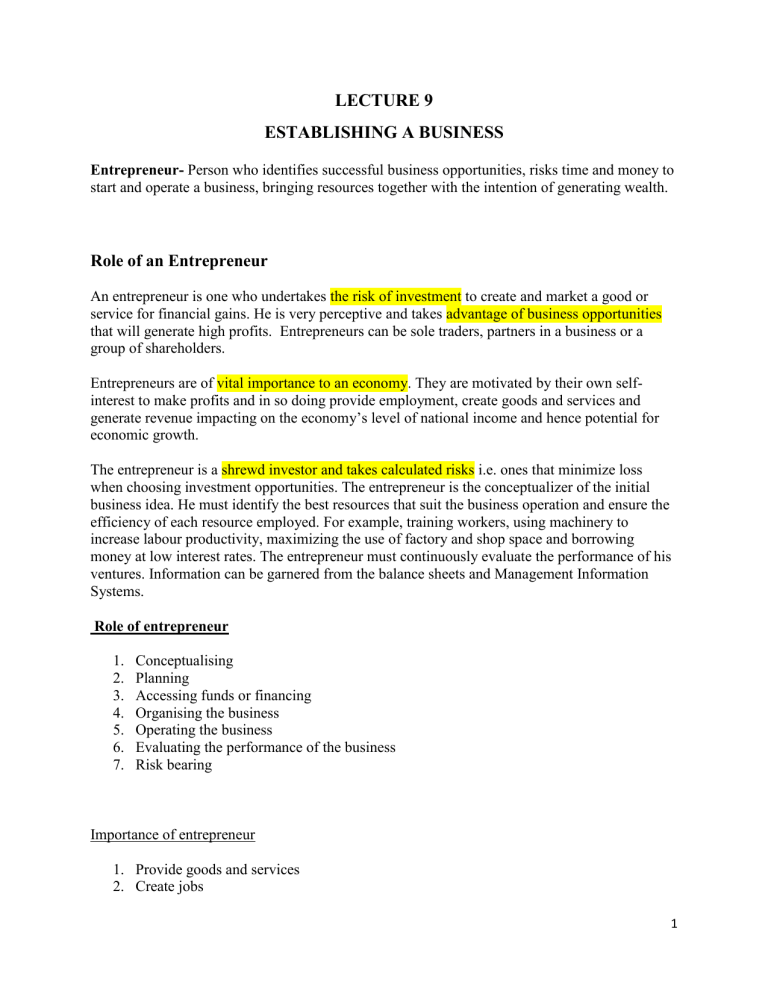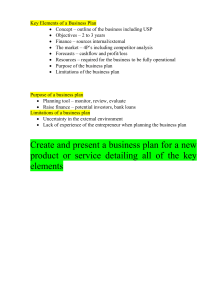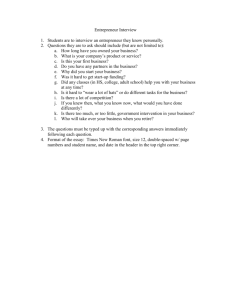
LECTURE 9 ESTABLISHING A BUSINESS Entrepreneur- Person who identifies successful business opportunities, risks time and money to start and operate a business, bringing resources together with the intention of generating wealth. Role of an Entrepreneur An entrepreneur is one who undertakes the risk of investment to create and market a good or service for financial gains. He is very perceptive and takes advantage of business opportunities that will generate high profits. Entrepreneurs can be sole traders, partners in a business or a group of shareholders. Entrepreneurs are of vital importance to an economy. They are motivated by their own selfinterest to make profits and in so doing provide employment, create goods and services and generate revenue impacting on the economy’s level of national income and hence potential for economic growth. The entrepreneur is a shrewd investor and takes calculated risks i.e. ones that minimize loss when choosing investment opportunities. The entrepreneur is the conceptualizer of the initial business idea. He must identify the best resources that suit the business operation and ensure the efficiency of each resource employed. For example, training workers, using machinery to increase labour productivity, maximizing the use of factory and shop space and borrowing money at low interest rates. The entrepreneur must continuously evaluate the performance of his ventures. Information can be garnered from the balance sheets and Management Information Systems. Role of entrepreneur 1. 2. 3. 4. 5. 6. 7. Conceptualising Planning Accessing funds or financing Organising the business Operating the business Evaluating the performance of the business Risk bearing Importance of entrepreneur 1. Provide goods and services 2. Create jobs 1 3. Increases the GDP or value of goods produced. 4. Utilize local raw materials 5. Earns foreign exchange Personal Qualities of an Entrepreneur Entrepreneurship requires the following characteristics for success: 1. The creativity to innovate new product and ideas. 2. Innovation 3. The drive and determination to be successful. 4. The ability to take calculated risks. 5. The flexibility to adapt to changes in the market and industry. 6. Very goal- oriented to purposely and aggressively accomplish task and meet objectives. Reasons Persons Establish their own Businesses 1. Financial Independence Some persons feel restricted financially with the income received from their job. Starting a business would give them the opportunity to be a successful business person and achieve financial independence. 2. Being your own boss You are able to make decisions about the direction and operation of the business. 3. To use your skills and knowledge for yourself The skills, knowledge and experience that you have acquired can be put to work for you. 4. Self-actualization/fulfilment Owning and operating a successful business will give a feeling of accomplishment. 5. To create employment for relatives, friends and community members 2 Businesses can assist in providing jobs for persons in communities with high levels of unemployment. Steps in Establishing a Business 1. Conceptualization All business ventures begin with the conceptualization of an idea. At this initial stage the product or service idea is envisioned. Most Entrepreneurs identify a need in the market i.e. a service that is not being provided or a product that does not exist. If the product or service already exists then ideas to make improvements may be conceptualized. 2. Research The entrepreneur is a shrewd investor and takes calculated risks. Before investing money in a business venture a market research must therefore be done to ascertain the extent of the need for the product or service. This helps to minimize losses. A market research involves gathering information about a potential market to help an investor make decisions about entering that market. 3. Identification of resources What resources are needed to start the business? If the market research is favourable the entrepreneur must now identify the necessary resources to operate business. The resources required are land, labour and capital. Land refers to location or place used to set up a business. This may be bought, rented or family home. Labour employed must be qualified and skilled to efficiently carry out their duties. Capital includes money, raw material and assets such as machinery and equipment. 4. Creation of a business plan Preparing a business plan is very important before the start of a business. This will help the business to ascertain whether or not the business will be profitable. A business plan outlines the goals of a business and the strategies that will be employed to achieve them. Usually financial institutions require that a business plan be presented when a loan is requested for business investment. 5. Acquisition of funds There are several ways of acquiring funds to start a business. There are a myriad of financial institutions that are willing to assist small businesses once their business plans are deemed workable. The investor must weigh the advantages and disadvantages of acquiring funds from 3 the various financial institutions. The cost of borrowing i.e. the interest rate charged and the length of the repayment period are factors to consider. Funds may be borrowed from friends and relatives that may attract a lower or no repayment cost and a more flexible repayment schedule. Funds can also be acquired from personal savings. Encouraging partners or selling shares are ways of avoiding high costs of capital. 6. Operation of a business A business must be efficiently operated to ensure high quality goods and service. This is important to keep existing customers and for business growth. Many companies employ an operation manager to design and oversee its operations. This person develops and manages the various processes used to create goods and services efficiently to ensure customer satisfaction. Sources of Research in Establishing a Business Firms embark on research to uncover information about consumer preferences, the level of competition in the market, responses to advertisement etc. Sources of Information Data may be collected from primary or secondary sources. (a)Primary Data Primary data is originally collected data. This data will be obtained by interviewing, observing or distributing questionnaires to the sample population. (b) Secondary Data Secondary data is information that has already been collected by someone else originally. This data will be therefore obtained from books, newspapers, magazines, libraries and publications of various institutions. Process between Planning and the Operation of a Business Managers must continue to plan in order to ensure that its operations meet all long – term, medium- term and short- term goals. Long- term plans are made for 3 to 5 year periods. Long-term plans determine the direction of the company. These plans set out the firm’s overall strategy to move from its present position to where it intends to be. Long-term plans include expansion plans and plans to create new products 4 and services. Long-term plans are made by the directors or persons in senior management positions of a company. Medium-term plans range from 1 to 2 years. They are made by department managers or persons in middle management positions. Medium term plans include increasing the efficiency of a department in order to increase the quality and quantity of output. This would involve implementing training programmes for staff and identifying equipment that would increase efficiency. Short-term plans are made daily, weekly and monthly by supervisors or persons in lower level management positions. These plans are centred on meeting daily, weekly and monthly production targets. Regulatory Practices Instituted by Governments A business is not considered a legal entity if it is not registered as business in the country where it operates. All persons desirous of starting a business must first be registered with the government agency authorized to carry out registration of business in their country. A sole trader only needs to register his business by meeting the requirements outlined for sole traders by the registering office and filling out the required documents. Partnerships are also registered by the completion of a registration document. The names of all the partners must be listed on the document. Partners in a business are advised to draft a Deed of Partnership. This document sets out all the rules that govern the partnership and will thus help to prevent conflict among partners. The formation of public and private limited liability companies involves the preparation of a number of documents. The Companies Act contains the laws relating to companies. To comply with certain requirements which were laid down by the Companies Act, the promoters of the company must present the following documents: 1. The Memorandum of Association – this document governs the company’s relationship with the outside world. It contains: (a) The name of the company (b) The address of the registered office (c) The objectives of the A statement of limited liability to members (d) The amount of capital to be raised by the selling of shares and the types of shares to be issued 5 (e) The number of shares to be taken by the directors (f) Statement of intent to form a limited liability 2. Articles of Association – this document contain the internal rules and regulations which govern the company. It contains: (a) The rights and obligations of the directors (b) The procedures for calling an annual general meeting (c) Procedures for electing directors (d) The borrowing powers of the company In order to effect the registration of a company, the Memorandum and Articles of Association must be prepared by a lawyer or any person named in the articles as a director or company secretary and sent to the companies registering office. 3. Statutory Declaration – this document states that the promoters of the company have compiled with the Companies Act. It is a signed statement from each director certifying their willingness to serve. 4. Certificate of Incorporation Once all three documents above have been submitted and the Registrar of Companies is satisfied that all is in order, it will enter the name of the company on the register, and issue a certificate of incorporation. The certificate of incorporation is proof that all requirements of the Companies Act have been complied with. The certificate of incorporation establishes the firm as a legal body. 5. The Incorporated Company A company always means an incorporated company. If a company is not incorporated, it is really a large partnership. Every business that has more than twenty shareholders must be registered as an incorporated company. The advantage of incorporation is that each member’s liability is limited. At this stage it is only the private limited company that may begin trading. 6. The Prospectus The public limited liability company must first publish its prospects inviting the public to subscribe for shares. This may be a publication in the newspaper or in another public media. The prospectus will contain information on the assets, liabilities and profit levels of the company. 7. Certificate of Trading Once the public limited liability company has collected the total amount of share capital stated in the memorandum, the company will then be issued with a Certificate of Trading. This will allow the company to start trading. 6 Sources of Capital in Setting up a Business Capital is one of the resources required to set up a business establishment. Capital mainly refers to those assets that are used to start and continuously operate a business. Fixed capital includes machinery, equipment and vehicles owned by the company. These assets are so called because they cannot easily be turned into cash. Circulating capital includes raw materials, finished and semi-finished, goods, bank and cash balances. These assets can easily be converted into cash. Sources of Capital - Personal savings of the owner or owners - Assistance from friends and family - Loan from a financial institution - Selling shares - Forming Partnerships - Debentures - Venture Capitalist Collateral – is money or property that is pledged as security for repayment of a loan. Guarantor – someone who gives a legally binding promise to be responsible for the debt of another person or to carry out some other legal obligation of the other person. The significance of collateral in accessing capital to establish a business Collateral is anything of value that is used to secure a loan. It is required by financial institutions for the approval of loans. If the loan is not repaid then the financial institution has the authority to seize the borrower’s collateral. Forms of collateral include: bank balances, motor vehicle, dwelling house, land, machinery and equipment etc. Evaluation of Different types of collateral Property- used for large loans for a long time Stocks- Any size loans 7 Bonds- Any size loans Money- Any size loans Cash surrender on insurance policies- Any size loans Motor Vehicles- small and medium loans for a short period Other assets (Appliances)- small and medium loans for a short period The value or importance of collateral Important to an entrepreneur to raise finance for business. Features of a Business Plan A business plan is a document outlining the goals of a business and the strategies to achieve these goals. It is mainly prepared by new businesses or by ones making major changes. Executive Summary The Executive Summary is a synopsis of the full business plan. It presents the salient points of the plan. It contains information on the purpose of the business, its methods of operation and future expectations. History of the business This section gives full details on previous operations of a business. For a new business it will explain where the idea came from and the reasons for starting the business. Mission Statement The Mission Statement gives the overall goal of a business as well as its values. It serves as a guide to the operation of the business. For example: providing the highest quality goods and services. Business goals and objectives The firms’ short-term, medium-term and long-term goals and the time in which these are to be achieved is outlined in this section. Organization The business must state the ownership structure and give details of the management team. 8 SWOT Analysis Looks at the strength and weaknesses of the business E.g. Strengths – strategic location, years of experience Weakness – Loans at affordable interest rates, Industry Analysis How has the industry changed in the past few years and who are the other firms in the industry. Product /Service Description Describe clearly the product or service that you will be offering. Market Analysis Describe your target market and your competitors. Marketing Strategy Explain the various promotional, pricing and distribution strategies. Operations Explain how the business will function on a day-to-day basis. For example: Procurement of raw materials, the use of technology and operating methods. Sales Forecast What amount of sales the business expects to make on a monthly basis. Start –up Cost The total amount needed to start the new business, giving a detailed description of what the money will be used for. Operating costs E.g. fixed Costs (rent, insurance and salary) and variable costs (utilities and wages) Projected Cash Flow An estimate of how much you expect to earn periodically once you start operating. 9 Acquisition of Funds Information on how funds will be obtained e.g. personal savings, borrowing from friends and family, borrowing from financial institutions or by selling shares. Benefits of a Plan - Ensures that careful research is conducted into the feasibility of the business. Anticipates needs and problems which can be planned for in advance. Provides a written document that can be used when requesting financing. Purpose of Feasibility Study This is an analysis of the viability of a business idea, and an examination of the different aspects of operating a business. It will show whether a business venture is worthwhile. It will analyse: - Market demand Target market Profitability Production methods Operating expenses Distribution channels Competition Promotional requirements Cash flow Resources required Any special legal requirements Ethical and Legal Issues Business owners are required to obey all legislation concerning the operations of a business. These include, paying taxes, business registration, obtaining licenses when required etc. Business owners should also operate their business based on integrity. This involves: - Environmental awareness – reducing pollution and harmful effluents in the rivers and seas. - Avoiding tied selling (marrying of goods) - Misleading advertising (untruths about goods advertised) 10 - Untrue sale price – For example, writing the word sale on items for which the price remains the same. - The use of market dominance to squeeze firms out of the industry- For example large firms may drop the price of their goods so low that small firms are unable to compete with them. Consequences of Unethical and Illegal Practices Illegal business practices will result in legal consequence for business. This may include large fines the loss of the business. Legislation also protects consumers, competitors and society from unethical practices of a business. Ethical and Legal Issues Ethical and Legal Description practices Consequences Advertising Misleading Advertising Withholding tax Honest and realistic advertisements Mandatory Cause citizens to waste a purchase Tax avoidance Environmental Issues Unethical disposal of waste Pollution Money (gained legally vs illegally) Money launderinguse of illegal money in legitimate business Law mandates protection of environment Illegal business activity Taxation Too much money circulating. Distortion of National Income 11

